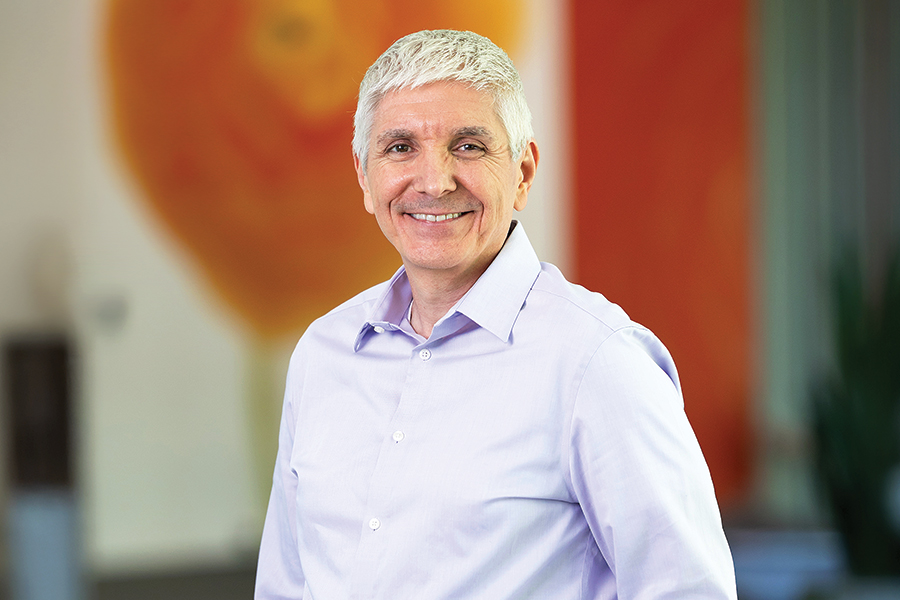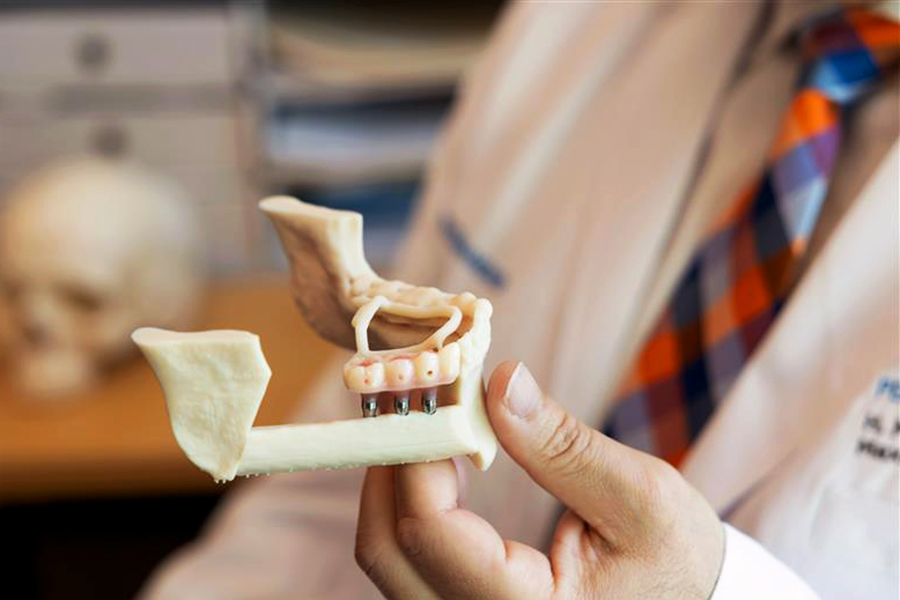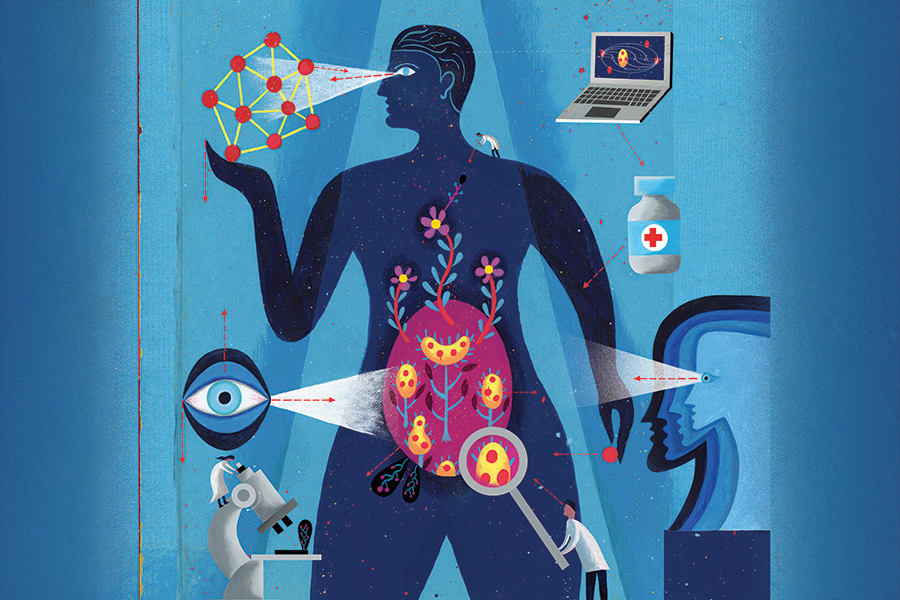August 12, 2025
It’s not every day that physicians get to work alongside a colleague who possesses that rare combination of expertise in technology and an artist’s eye for how to get the most from it. Gregg Gayre, MD, chief technology officer in The Permanente Medical Group (TPMG), is that colleague.
“I regularly refer to him as ‘the Picasso of the technology world,’” says Kristine Lee, MD, TPMG associate executive director. “He’s a master visionary — he thinks creatively about how different solutions can fit together to address our needs, with the ideas often arriving in unexpected shapes and configurations.”
Dr. Gayre, who is also an oculoplastic ophthalmologist and medical informaticist, has been putting paintbrush to canvas since joining TPMG over 20 years ago. Throughout his career, he has used his unique background and perspective to develop comprehensive technology solutions to health care challenges.
Prior to his current role, Dr. Gayre served as TPMG’s medical director for technology integration and the physician lead for KP HealthConnect in Kaiser Permanente Northern California. In these roles, he assumed leadership of the ambulatory electronic health record (EHR) in 2012 and was responsible for modernizing the layout and introducing numerous enhancements to improve usability. He also began work on e-visits in 2017, helping to shape new models of virtual care that continue to evolve today.
In 2024, Dr. Gayre received a Sidney Garfield Exceptional Contribution Award for a project that provides ophthalmologists with quick, easy access to digital eye images. The project, which he co-led with Bonnie Quiroz, MD, has proven so successful that the technology will soon be used across Kaiser Permanente (KP) nationally.
Permanente Excellence spoke with Dr. Gayre about his background, his goals for the organization as chief technology officer, and health technology on the horizon.
Q: Tell us about your background. What drew you to become a physician?
I grew up in a small town in the rural South. My parents were teachers and very involved in the community, so it seemed natural for me to have a job serving others. The smartest person I knew was my older brother, and he became a doctor. I didn’t think I could do that, but I realized when I was in college that I could keep up with all the pre-med students, so I followed in his footsteps. Over time, I came to appreciate that medicine offers a unique mix of science, problem-solving, and human connection — and that combination has kept me engaged ever since.
Q: How did you become interested in ophthalmology?
When I applied for a fellowship program, there were only about 500 practicing oculoplastic surgeons in the country. I was fortunate to meet one of them during my first year of medical school. I loved the idea of being a surgeon and using my hands to deliver care — especially in a field like oculoplastics, where both precision and artistry are involved.
But what truly drew me in was the eye itself. One of the most spiritual moments of my training was witnessing my first corneal transplant. I saw the iris unobstructed — its intricate muscle fibers fanning out in delicate patterns, shimmering in the light, and responding instantly to the environment. It felt like seeing a hidden masterpiece that few get to witness. That moment stayed with me.
Q: Why did you join The Permanente Medical Group?
I was very much a fish out of water where I grew up. Most people didn’t go to college, and a nerdy bookworm like me never quite fit in. I wanted a fresh start and found a position in the Bay Area with TPMG.
At first, I didn’t fully grasp the power of the Permanente model. But once I experienced how value-based care, evidence-based practice, and an integrated system could come together to improve patient outcomes, I was all in. What really sealed it for me was the culture — being surrounded by smart, mission-driven colleagues who are focused on doing the right thing for patients. No health care system is perfect, but I genuinely believe Kaiser Permanente is the best model for care in the country.
Q: How did you become interested in informatics and technology?
Just a little over three years into my career with TPMG, I unexpectedly became chief of the Ophthalmology Department due to a colleague’s medical issue. It was an early leadership opportunity, and while I was growing as a surgeon and physician, I found myself increasingly frustrated by the outdated, clunky technology we were using. Then KP HealthConnect was introduced, and I immediately recognized that the EHR was going to become as essential to a physician’s toolkit as the stethoscope.
I wanted to make it better — more intuitive, less disruptive, and truly supportive of patient care. That’s what drew me to medical informatics. I knew I needed to understand how Epic and IT teams think, so that I could bring the physician’s voice into the design process and advocate for smarter, more usable systems. That’s why I pursued board certification and began working at the regional and national level — because the tools we use every day should work for us, not against us.
Q: How has your background in ophthalmology and medical informatics shaped your approach to integrating technology?
Ophthalmology is inherently technology-rich. Every day, I rely on advanced diagnostics, imaging systems, and digital tools to deliver precise, high-quality care. That exposure taught me early on that when technology is well designed, it enhances the clinical experience — for both patients and physicians. When it’s not, it creates friction, inefficiency, and frustration. Medical informatics gave me the framework to bridge that gap: to understand clinical workflows deeply, and to ensure the tools we implement support care delivery, not get in its way.
Q: What role do you believe technology should ideally play in health care, and why is it important for physicians to be involved?
Technology should reduce the administrative burden on physicians while empowering patients to manage routine aspects of their care more independently. We need to use technology to take care of the tasks that don’t require a physician’s time: things like scheduling appointments, ordering refills, accessing lab results, and answering common questions. If a patient needs a mammogram or routine lab work, they should be able to receive a simple reminder and take action with a few taps on their phone.
These kinds of self-service tools don’t replace the physician — they free us up. They let us spend our time where it matters most: engaging with patients on the complex, nuanced, and human parts of care. When we do see patients, virtually or in person, technology should enhance that interaction, not distract from it.
That’s why physician involvement in technology design is so essential. We understand what the clinical workflow looks like and how patients move through the care journey. Developers and technologists bring important skills, but without physician input, digital tools often miss the mark — they either oversimplify clinical judgment or add complexity in the wrong places.
Q: What challenges did you hope to address when you took on the role of chief technology officer in 2023?
One of the first things I recognized was that we had multiple talented technology teams working across the medical group, but often in silos. My goal has been to bring those teams together into a unified structure, aligning around a common strategy that maximizes our investment in Epic.
We’ve adopted what I call an “Epic-first” strategy. That means we take full advantage of what Epic offers at its core — leveraging the tools they develop early and integrating them deeply into our workflows. From there, we focus our energy and creativity around the periphery, where Epic may not yet have gone, and where we can design enhancements that are uniquely suited to our patients, clinicians, and care model. This approach allows us to build a best-in-class experience while maintaining the flexibility to innovate where it matters most. It also keeps us competitive and forward-looking.
When our teams work together — across clinical, operational, and technical domains — the result is a system that feels seamless for the end user. Patients and physicians shouldn’t feel like they’re moving between disconnected tools; everything should work together fluidly. That’s how we reduce friction and create an experience that supports care rather than complicating it.
At the end of the day, technology is just a means to an end. In health care, it’s meant to support documentation, surface relevant information, and enable great care. But the evolution of the EHR brought with it a wave of administrative burden that has weighed heavily on clinicians. One of my guiding principles is to reduce that burden wherever we can, so that technology helps clinicians focus on what they do best: caring for patients.
Q: What are some of the technology milestones in TPMG that you’re most excited about?
MyChart, Epic’s integrated patient portal, is top of mind. When we deployed KP HealthConnect in 2004, MyChart was still in its infancy, and we made the decision to build our own patient portal within kp.org. It has served us well for nearly two decades, but MyChart has matured significantly and now offers a more seamless and robust experience.
From a patient perspective, MyChart makes it easier to access health information and perform routine tasks like messaging their doctor, refilling medications, or viewing test results — all in one place. For clinicians, it reduces friction by eliminating the middleware we’ve had to rely on to interact with our patients online. MyChart also has a feature called Care Companion, a digital team member that supports patients through specific care journeys. Whether it’s recovery after surgery or managing a chronic condition, Care Companion provides interactive, tailored guidance when patients need it most. It’s another step toward making our digital experience feel more human, responsive, and supportive.
What really excites me, though, is how MyChart positions us to elevate population health management. Kaiser Permanente already leads in this space, but MyChart allows us to become even more proactive and personalized. For instance, we can identify patients overdue for a screening — say, a mammogram or diabetic eye exam — and send a timely nudge via the app. Even better, we can connect that outreach to self-scheduling tools or offer reminders when the patient is physically at a medical center: “You’re here already — why not stop by the lab or imaging department?” That’s where digital engagement becomes tangible and impactful.
Another major milestone this year was instance consolidation — essentially unifying all the separate instances of KP HealthConnect across Northern California into a single coordinated platform. Until recently, we were operating six subregional versions of the EHR, which meant we had to do a lot of behind-the-scenes work to keep a patient’s entire record intact when they crossed regional boundaries.
Now, with one EHR instance, it’s truly “one patient, one practice, one population, one platform.” Clinicians have complete visibility into a patient’s history no matter where they receive care, and patients can access virtual or in-person visits without geographic constraints. It frees up time, resources, and mental bandwidth that we used to spend just trying to make the systems talk to each other — and we can now focus on what’s next.
Q: What inspired the integration of Sectra imaging technology in ophthalmology?
About eight years ago, TPMG launched an initiative for each specialty to operate as a unified department across the organization. As a new technology leader at the time, I quickly heard from colleagues about significant challenges in accessing images — an increasingly vital aspect of ophthalmology. We had been storing images and data outside of KP HealthConnect in a secure, image-based system analogous to the EHR. It was unreliable, frequently crashing and failing to load, which created real friction.
I became aware of Sectra because of its strong integration with Epic in Europe, where the two companies were enabling seamless clinical workflows. During the pandemic, Dr. Bonnie Quiroz and I partnered virtually with Sectra developers in Sweden, meeting with them every Wednesday morning, to design and build the new system in just a few months. It’s far more usable and fully integrated with KP HealthConnect. Experiencing the power of a single platform has underscored that this should become the standard for all PACS [picture archiving and communication system] imaging. Within a year, physicians across TPMG, from radiology to dermatology to cardiology, will be using Sectra.
Q: Are there other promising future technologies, such as AI or tech that reduce the administrative burden for physicians?
My North Star has always been something that feels a bit like Star Trek — a future where clinicians interact with technology the way we interact with each other: through voice, presence, and eye contact. That’s what feels natural. Keyboards and screens are artifacts of a transitional era — they’ve never aligned with the way we think, speak, or care for patients.
Ambient listening technology is one of the bridges to that future. I first explored it years ago, but the technology just wasn’t mature. Then in 2022, the release of ChatGPT provided the breakthrough that ambient platforms needed — suddenly machines could understand context and language in a more human way. We launched a pilot in TPMG using Abridge, and the results were remarkable. Physicians could now document visits using their voice, allowing them to focus more fully on their patients. That success led to a national KP rollout.
Since October of last year, every TPMG physician in Northern California has access to Abridge. But like any transformative shift, adoption takes time. We have to support our colleagues, especially those less familiar with new tech, by giving them the time, training, and encouragement they need to incorporate it into their practice. We believe the impact will be profound.
Looking ahead, systems like Abridge won’t just be voice recorders or transcription tools — they’ll evolve into intelligent digital assistants. Imagine a holographic presence in the exam room, one that listens, understands, and responds — surfacing key clinical insights from years of chart history, highlighting what could be lifesaving in a 15-minute visit, or even translating complex medical explanations into clear, accessible language for patients. That’s the trajectory we’re on. These tools will help restore the human connection in medicine by removing the digital noise that stands in the way.
Q: What advice do you have for other physicians who are interested in technology and want to develop leadership skills?
At its core, the role of an informaticist is about translating clinical experience into a compelling vision for how technology can improve care delivery. It starts with understanding the real challenges your department faces — what’s not working, what’s creating friction for patients or clinicians — and being able to tell that story in a way that resonates. From there, it’s about imagining how digital tools could meaningfully address those challenges, even if the ideal solution doesn’t yet exist.
You don’t need to be a technologist to lead in this space. What you do need is the ability to articulate a future state and collaborate with IT partners to bridge the gap between where we are and where we want to go. Think of something like MyChart not just as a patient portal, but as the foundation for something much more dynamic, like a personalized digital assistant. That kind of thinking helps drive innovation. Physicians bring a unique perspective grounded in care delivery, and when paired with the technical expertise of our IT colleagues, that’s when transformative change becomes possible.
This article originally appeared in Permanente Excellence, the magazine for physicians in The Permanente Medical Group.






